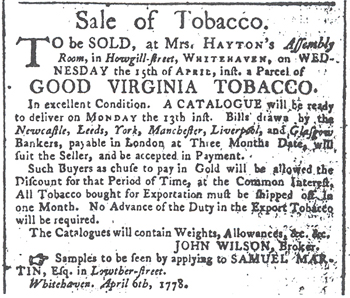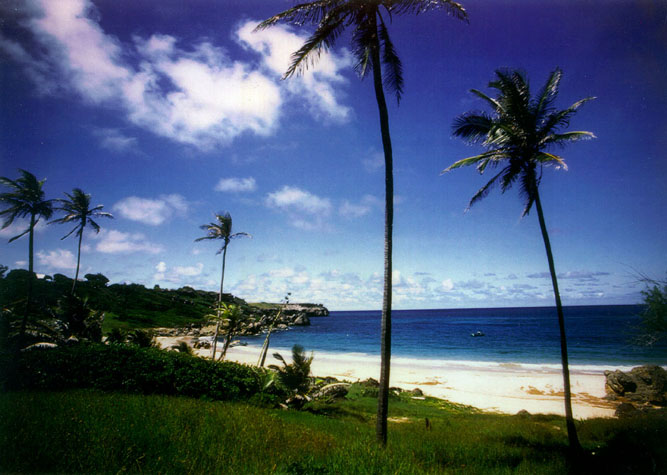The cornerstone for the current "cathedral of the Navy" was laid
by Admiral George Dewey in June 1904, and the Chapel was dedicated in May 1908.
It was originally designed in the shape of a Greek cross with equal transepts.
The dome was originally decorated with terra cotta military emblems and devices.
These were removed in 1928 because of weather damage and expense of maintenance.
A nave was added to the Chapel in 1939-40, making it a Latin cross and increasing
the seating to 2,500. Although architect Ernest Flagg considered the crypt of
the Chapel as a potential tomb for naval heroes, particularly John Paul Jones,
funds were not provided for its completion for this purpose until 1912.
03 July 1997 (Above notes derived from US Naval Historical Center Washington
DC)
Following the recent news that a replica of the ship, Ranger, may be built
in Whitehaven, plans are currently in place in Portsmouth, New Hampshire,
USA, to construct a replica. Portsmouth is the place where the ship was originally
constructed and launched.
In 2001 AMERICAN divers have been warned off the deep sea wreck site of Jones'
warship the Bonhomme Richard. The vessel, sunk off the Yorkshire coast, near
Filey, was the first warship of the newly independent United States.
Now, US divers are keen to search out the ship's treasures but after a tip-off
to Government officials from the Department of Culture, Media and Sport last
week that an American diving team was preparing to raise precious artefacts
from the wreck, believed to be that of the 40-gun Bonhomme Richard, action
was taken. Arts minister Lady Blackstone issued an emergency order barring
an approach to the wreck. She said it was understood that the wreck had caught
the eye of salvors and there were concerns it might have been stripped within
days.
THE PIAZZA AT MOUNT VERNON
Before the start of the American War of Independence some 1500 one foot square
flag stones were needed to pave the Piazza at Mount Vernon, the home of George
Washington. They were ordered from George Rumney, a Whitehaven merchant ship
owner as Whitehaven stone had been specified. The flag-stones were delivered
in 1786. In 1914 the stones were becoming worn and replacements were ordered
by McKays Quarry at St Bees, from which the original red sandstone flags had
come over a century earlier. Such dressed stone proved a useful cargo, doubling
up as ballast.
BROCKLEBANKS
Around 1650 shipbuilding had started in earnest
at Whitehaven. The building was in response to the needs of the coal trade.
Possibly the most famous builder was Daniel Brocklebank (1742-1801) The founder
of the world's oldest registered shipping line. At the age of 28 Daniel crossed
the Atlantic and established a ship building yard at Sheepscutt, Maine. Becoming
acutely aware of the increasing hostility between the British Crown and the
American colonists, he decided to abandon this venture and in 1775 returned
to Whitehaven. Here in Whitehaven he resumed his work and in 1782 set up a
yard at North Shore. Here he built some 27 vessels before his death, the business
being continued by his descendants. In 1819 Brocklebanks established a shipping
concern at Liverpool. This company was later acquired by the Cunard Line,
whose claim to be the oldest registered shipping line is derived from the
Whitehaven connection.
TRANSATLANTIC CABLE
It was a seaman apprentice with Brocklebanks, James Anderson, who had involvement
in another important American link. The first internet link in a sense! Anderson
was promoted rapidly and took command of the Great Eastern which had been
commissioned to take the transatlantic cable under the Atlantic in 1866. As
a reward Queen Victoria bestowed a knighthood on Anderson.
OTHER WHITEHAVEN LINKS The tall ship, the Vicar of Bray built at Whitehaven
by Robert Hardy in 1841 plied the Atlantic for over thirty years. She is the
only surviving vessel that took miners out to the goldfields in the Californian
gold rush of 1849. In 1870 she was damaged in the stormy Southern oceans and
now languishes as a hulk in the Falkland Islands.
Whitehaven-Virginia's Tobacco
Trade In an early reference SirJohn Lowther's agent describes "three Whitehaven
ships loading" tobacco in Virginia in 1683. By 1697 reports spoke of
18 ships bound for Virginia. By 1725 the tally was 28. In 1742 customs officers
at Whitehaven (A post later held by William Wordsworth's uncle Richard) spoke
of "no less than 50 sail of ships employed to Virginia and Maryland for
this year's importation of tobacco.''
In an early reference SirJohn Lowther's agent describes "three Whitehaven
ships loading" tobacco in Virginia in 1683. By 1697 reports spoke of
18 ships bound for Virginia. By 1725 the tally was 28. In 1742 customs officers
at Whitehaven (A post later held by William Wordsworth's uncle Richard) spoke
of "no less than 50 sail of ships employed to Virginia and Maryland for
this year's importation of tobacco.''
The tough collier ships built to carry coal to Dublin were tough enough for
the demanding trans-Atlantic voyages as the value of tobacco made the voyages
worth the risks. The ships carried outward bound textiles and plantation shoes
and leather goods. Also pots and pans and all the necessary goods to help
supply the early US colonies. Average Atlantic crossing times were around
10 weeks. Vessels were typically 190 tonners. To help feed the crews the top
decks often featured hens, pigs and geese. The tobacco bought out in the new
colonies were shipped home in standard hogheads. In a bizarre aspect of Whitehaven's
thriving tobacco trade were the Bransty "pipes" chimneys on the
cliff tops from which seized contraband tobacco was burned. For more detail
please see Whitehaven and the Tobacco Trade by Nancy Eaglesham; available
via http://www.abebooks.co.uk.
The other Whitehaven in Maryland USA was named after its Cumbrian namesake.
The Village of Whitehaven makes a quiet home base for a visit to the Eastern
Shore of Chesapeake Bay. An hour away, visit the Bright Lights of Ocean City,
Maryland or the unspoiled beaches of Assateague Island. Bird Watch at the
Blackwater Wildlife Refuge and Assateague Wildlife Refuge or tour the Historic
Sites of this old and lovely land. The level ground and quiet roads are ideal
for Biking. Fine Public Golf Courses abound.
ROBERT SALMON The Father of American School of Marine Artists was born in
Whitehaven in 1775 and specialised in paintings of ships. In 1828 he sailed
to America and was in Boston 14 years.
(Help with much of the above information from Mr Harry Fancy, former Whitehaven
museum curator)
Home page /Where to stay in the Lakes | What to do and see in the Lakes
| Lakestay E mails
Copyright © Lakestay All rights reserved.


 In an early reference SirJohn Lowther's agent describes "three Whitehaven
ships loading" tobacco in Virginia in 1683. By 1697 reports spoke of
18 ships bound for Virginia. By 1725 the tally was 28. In 1742 customs officers
at Whitehaven (A post later held by William Wordsworth's uncle Richard) spoke
of "no less than 50 sail of ships employed to Virginia and Maryland for
this year's importation of tobacco.''
In an early reference SirJohn Lowther's agent describes "three Whitehaven
ships loading" tobacco in Virginia in 1683. By 1697 reports spoke of
18 ships bound for Virginia. By 1725 the tally was 28. In 1742 customs officers
at Whitehaven (A post later held by William Wordsworth's uncle Richard) spoke
of "no less than 50 sail of ships employed to Virginia and Maryland for
this year's importation of tobacco.''